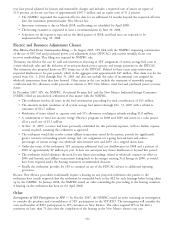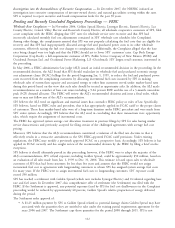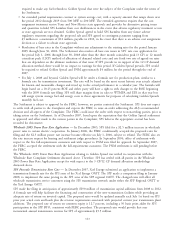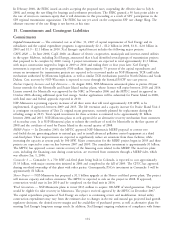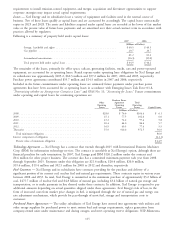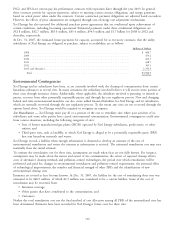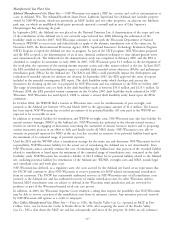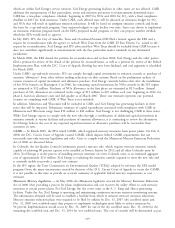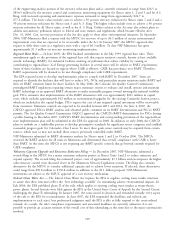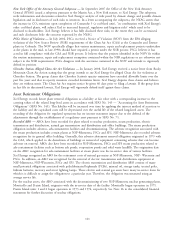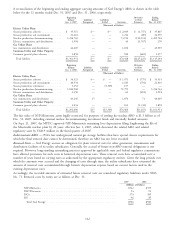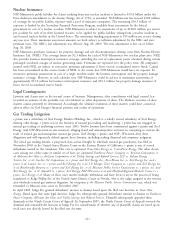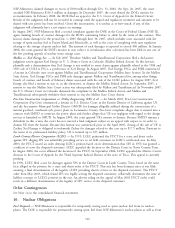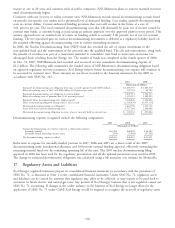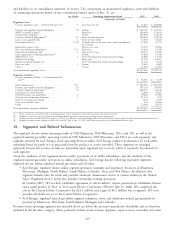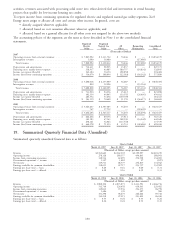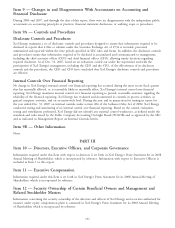Xcel Energy 2007 Annual Report Download - page 131
Download and view the complete annual report
Please find page 131 of the 2007 Xcel Energy annual report below. You can navigate through the pages in the report by either clicking on the pages listed below, or by using the keyword search tool below to find specific information within the annual report.New York Office of the Attorney General Subpoena — In September 2007 the Office of the New York Attorney
General (NYAG) issued a subpoena pursuant to the Martin Act, a New York statute, to Xcel Energy. The subpoena
seeks information and documents related to Xcel Energy’s analysis of risks posed by climate change and possible climate
legislation and its disclosures of such risks to investors. In a letter accompanying the subpoena, the NYAG asserts that
the increase in CO2 emissions upon completion of Comanche 3 (a coal-fired unit), ‘‘in combination with Xcel Energy’s
other coal-fired plants, will subject Xcel to increased financial, regulatory and litigation risks’’ which need to be
disclosed to shareholders. Xcel Energy believes it has fully disclosed these risks, to the extent they can be ascertained,
and such disclosures belie the concerns expressed by the NYAG.
PSCo Notice of Violation — In July 2002, PSCo received a Notice of Violation (NOV) from the EPA alleging
violations of the New Source Review (NSR) requirements of the Clean Air Act (CAA) at the Comanche and Pawnee
plants in Colorado. The NOV specifically alleges that various maintenance, repair and replacement projects undertaken
at the plants in the mid- to late-1990s should have required a permit under the NSR process. PSCo believes it has
acted in full compliance with the CAA and NSR process. It believes that the projects identified in the NOV fit within
the routine maintenance, repair and replacement exemption contained within the NSR regulations or are otherwise not
subject to the NSR requirements. PSCo disagrees with the assertions contained in the NOV and intends to vigorously
defend its position.
Cherokee Station Alleged Clean Air Act Violations — In January 2008, Xcel Energy received a notice letter from Rocky
Mountain Clean Air Action stating that the group intends to sue Xcel Energy for alleged Clean Air Act violations at
Cherokee Station. The group claims that Cherokee Station’s opacity emissions have exceeded allowable limits over the
past five years and that its opacity monitors exceeded downtime limits. Xcel Energy disputes these claims and believes
they are without merit. The Clean Air Act requires notice be given 60 days prior to filing a lawsuit. If the group does
in fact file its threatened lawsuit, Xcel Energy will vigorously defend itself against these claims.
Asset Retirement Obligations
Xcel Energy records future plant removal obligations as a liability at fair value with a corresponding increase to the
carrying values of the related long-lived assets in accordance with SFAS No. 143 — ‘‘Accounting for Asset Retirement
Obligations’’ (SFAS No. 143). This liability will be increased over time by applying the interest method of accretion to
the liability and the capitalized costs will be depreciated over the useful life of the related long-lived assets. The
recording of the obligation for regulated operations has no income statement impact due to the deferral of the
adjustments through the establishment of a regulatory asset pursuant to SFAS No. 71.
Recorded ARO — AROs have been recorded for plant related to nuclear production, steam production, electric
transmission and distribution, natural gas transmission and distribution and office buildings. The steam production
obligation includes asbestos, ash-containment facilities and decommissioning. The asbestos recognition associated with
the steam production includes certain plants at NSP-Minnesota, PSCo and SPS. NSP-Minnesota also recorded asbestos
recognition for its general office building. Generally, this asbestos abatement removal obligation originated in 1973 with
the CAA, which applied to the demolition of buildings or removal of equipment containing asbestos that can become
airborne on removal. AROs also have been recorded for NSP-Minnesota, PSCo and SPS steam production related to
ash-containment facilities such as bottom ash ponds, evaporation ponds and solid waste landfills. The origination date
on the ARO recognition for ash-containment facilities at steam plants was the in-service date of various facilities.
Xcel Energy recognized an ARO for the retirement costs of natural gas mains at NSP-Minnesota, NSP- Wisconsin and
PSCo. In addition, an ARO was recognized for the removal of electric transmission and distribution equipment at
NSP-Minnesota, NSP-Wisconsin, PSCo and SPS. The electric transmission and distribution ARO consists of many
small potential obligations associated with polychlorinated biphenyls (PCBs), mineral oil, storage tanks, treated poles,
lithium batteries, mercury and street lighting lamps. These electric and natural gas assets have many in-service dates for
which it is difficult to assign the obligation to a particular year. Therefore, the obligation was measured using an
average service life.
For the nuclear assets, the ARO associated with the decommissioning of two NSP-Minnesota nuclear generating plants,
Monticello and Prairie Island, originates with the in-service date of the facility. Monticello began operation in 1971.
Prairie Island units 1 and 2 began operation in 1973 and 1974, respectively. See Note 16 to the consolidated financial
statements for further discussion of nuclear obligations.
121


